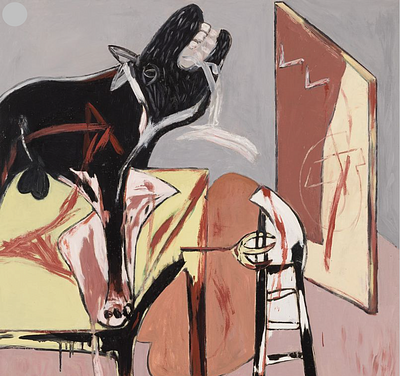EDUARDO ARROYO (Madrid, 1937-2018). "Personaje". Collage on paper.
Lot 55
About Seller
Setdart Auction House
Carrer Aragó 346
Barcelona
Spain
Setdart Subastas was born in 2004 and is currently the first online art auction in Spain with solidity, prestige and reliability guaranteed by our more than 60,000 users. Setdart has a young, dynamic and enterprising team ready to successfully manage the purchase and sale of art works through custom...Read more
Categories
Estimate:
EUR€8,000 - EUR€9,000
$8,602.15 - $9,677.42
Absentee vs Live bid
Two ways to bid:
- Leave a max absentee bid and the platform will bid on your behalf up to your maximum bid during the live auction.
- Bid live during the auction and your bids will be submitted real-time to the auctioneer.
Bid Increments
| Price | Bid Increment |
|---|---|
| EUR€0 | EUR€10 |
| EUR€200 | EUR€25 |
| EUR€500 | EUR€50 |
| EUR€1,000 | EUR€100 |
| EUR€3,000 | EUR€200 |
| EUR€5,000 | EUR€500 |
| EUR€10,000 | EUR€1,000 |
| EUR€20,000 | EUR€2,000 |
| EUR€50,000 | EUR€5,000 |
About Auction
By Setdart Auction House
Nov 16, 2021
Set Reminder
2021-11-16 08:00:00
2021-11-16 08:00:00
America/New_York
Bidsquare
Bidsquare : Contemporary and Actual Art
https://www.bidsquare.com/auctions/setdart-auction-house/contemporary-and-actual-art-7839
Setdart Auction House sofia@setdart.com
Setdart Auction House sofia@setdart.com
- Lot Description
EDUARDO ARROYO (Madrid, 1937-2018). "Personaje". Collage on paper. Signed in the lower left corner. With coaster of the Hotel Monasterio San Miguel (Puerto de Santa María) in the upper left corner. Measurements: 43 x 31 cm; 71 x 56 cm (frame). Painter, sculptor and engraver, Arroyo stands out as an important figure within the neo-figurativist movement. A key figure in the new Spanish figuration, Arroyo came to prominence on the national art circuit only belatedly, in the 1980s, after a two-decade-long period of estrangement forced by the Franco regime. Currently, his works hang in the most reputable Spanish museums and his creativity extends to theatrical scenographies and illustrated editions. Arroyo began his career in journalism, finishing his studies in 1957. He then left for Paris, fleeing the asphyxiating Spanish political climate of the time. Although his first vocation was as a writer, a task he continues to this day, by 1960 he was already making a living as a painter. That year, he participated for the first time in the Salón de Pintura Joven in Paris. His critical attitude towards dictatorships, both political and artistic, pushed him to controversial initiatives. He opted for figurative painting during the years of the overwhelming dominance of abstract painting in Paris, and his first themes were reminiscent of "black Spain" (effigies of Philip II, bullfighters, dancers), worked in a caustic and unromantic key. At the beginning of the sixties his plastic vocabulary moved under the North American influence of pop art, and in 1964 his break with informal art became definitive. His first public impact came in 1963, when he presented a series of effigies of dictators at the Third Paris Biennial, which provoked protests from the Spanish government. That same year, Arroyo prepared an exhibition at the Biosca Gallery in Madrid, which was inaugurated without his presence since he had to flee to France, pursued by the police; the exhibition was censored and closed a few days later. However, Arroyo's figurative option took a long time to be accepted in Paris. The painter rejected the unconditional devotion to certain avant-gardists, such as Duchamp or Miró, which he considered imposed by fashions. Actually, his interest is to demystify the great masters and defend the role of the market as protector and thermometer of art, as opposed to the network of museums and influences paid for with public money. In 1974, Arroyo was expelled from Spain by the regime, and he would not recover his passport until Franco's death. However, his critical takeoff in Spain was not immediate, and would be delayed until the early eighties. In 1982 he was awarded the National Prize for Plastic Arts, and anthological exhibitions were dedicated to him at the National Library in Madrid and the Pompidou Center in Paris. Currently, Arroyo is represented at the Museo Nacional Reina Sofía in Madrid, the Patio Herreriano in Valladolid, the Museo de Bellas Artes in Bilbao, the Hirshhorn Museum and Sculpture Garden in Washington D.C. and the Museo de Arte Moderno in Lille (France), among others.
- Shipping Info
-
In-house shipping available. Please inquire at admin@setdart.com.
-
- Buyer's Premium



 EUR
EUR CAD
CAD AUD
AUD GBP
GBP MXN
MXN HKD
HKD CNY
CNY MYR
MYR SEK
SEK SGD
SGD CHF
CHF THB
THB














